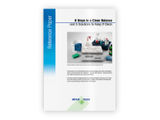To use all functions of this page, please activate cookies in your browser.
my.bionity.com
With an accout for my.bionity.com you can always see everything at a glance – and you can configure your own website and individual newsletter.
- My watch list
- My saved searches
- My saved topics
- My newsletter
Computed tomography angiographyCTA or computed tomography angiography, is an examination that uses x-rays to visualize blood flow in arterial and venous vessels throughout the body. This ranges from arteries serving the brain to those bringing blood to the lungs, kidneys, arms and legs. CT combines the use of x-rays with computerized analysis of the images. Beams of x-rays are passed from a rotating device through the area of interest in the patient's body from several different angles to create cross-sectional images, which then are assembled by computer into a three-dimensional picture of the area being studied. The scan is performed simultaneously with a high speed contrast media injection using a technique called Bolus Tracking. Compared to catheter angiography, which involves placing a sizable catheter and injecting contrast material into a large artery or vein, CTA is a much less invasive and more patient-friendly procedure. The contrast material is injected into a small peripheral vein by using a small needle or cannula. This type of exam has been used to screen large numbers of individuals for arterial disease. Additional recommended knowledgeMost patients undergo CT angiography without being admitted to a hospital. Clinical ApplicationsCTA is commonly used to:
CTA is also used to detect narrowing or obstruction of arteries in the pelvis and in the carotid arteries,which bring blood from the heart to the brain. When a stent has been placed to restore blood flow in a diseased artery, CTA will show whether it is serving its purpose. Examining arteries in the brain may help reach a correct diagnosis in patients who complain of headaches, dizziness, ringing in the ears or fainting. Injured patients may benefit from CTA if there is a possibility that one or more arteries have been damaged. In patients with a tumor, it may be helpful for the surgeon to know the details of arteries feeding the growth. Benefits and RisksBenefits
Risks
Categories: Medical imaging | Radiography |
| This article is licensed under the GNU Free Documentation License. It uses material from the Wikipedia article "Computed_tomography_angiography". A list of authors is available in Wikipedia. |
- Zimelidine
- T-cell immune response can control SARS-CoV-2 virus replication in immunocompromised patients
- Amphotericin_B
- Relationships inside a cell - Scientists publish the first RNA interactome of the human nucleus
- Lung Tissue from the Lab - Organoids could be used in diagnosis, drug development, and fundamental research







